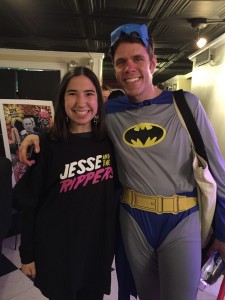I don’t mean to brag, but I binge-watched before binge-watching was cool.
Throughout elementary school, I tuned into Full House reruns with a vengeance. Every day—twice on ABC Family from three to four and twice on Nick at Nite from nine to ten—I laughed my way from season one to season eight over and over again. Whether Stephanie was driving a car through the kitchen, or Uncle Jesse was skydiving into a tomato truck, or Michelle was buying a pet donkey—everywhere you looked, I was watching Full House. The knee-slapping humor and well-crafted plotlines made for situations that captivated me; the punchy writing and first-rate cast made for characters that flew off the screen; the wholesome buoyancy and endearing life lessons made for episodes that appealed to both me and my parents. The Tanner family seemed like a real family, and I wanted in. During those half-hour windows of delightfully zany antics, I felt like a member of the gang.
Around age eleven, I gradually stopped watching Full House—I suppose that once you have seen every episode of a show a dozen times, the punch lines start to lose their pizzazz. I moved out of the Tanner residence and made myself comfortable in other small-screen locations, like the bustling William McKinley choir room in Lima and the cozy Central Perk coffeehouse in Manhattan.
But as Tony Bennett famously crooned, I most definitely left my heart in San Francisco.
In the eight years since my Full House phase drew to a close, I have revisited my old favorite every now and then: By taking the T into Boston to see Dave Coulier do standup comedy. By posing in front of the Tanners’ Edwardian housefront in San Francisco. By attending Perez Hilton’s uproariously dirty parody Full House! The Musical! in New York City. By stumbling upon an episode from time to time while eating dinner in front of the television or running on the treadmill.
And all these years later, when I catch a few moments of the show I once treasured, I am right back in elementary school. When Stephanie purses her lips and scowls her signature “how rude,” I can smell the fresh laundry that I used to fold as I enjoyed the show in my parents’ bedroom. When Danny merrily disinfects the kitchen cabinets, I can sense the rush of wind on my face as I ran home from the bus stop to make it to my living room in time for the theme song. When Uncle Jesse and Aunt Becky kiss on the blue-checkered couch in a flash of romance that set the standard for enviable relationships, I can recall the thrill of long recesses and the freedom of short to-do lists. When Kimmy bursts through the door and hollers “hola, Tanneritos,” I can taste the sweetness of chocolate milk boxes and the tartness of Flintstone vitamins. When Joey cracks his catchphrase “cut it out,” I can remember the joyfulness and the uncertainty, the simplicity and the complexity of being seven, eight, nine, and ten.
Thanks to creator Jeff Franklin and the good people at Netflix, I just might get to find my heart in San Francisco again. On February 26, Full House will come roaring back to life as the long-awaited 13-episode sequel Fuller House. Starring almost the entire original cast—Candace Cameron Bure, Jodie Sweetin, Andrea Barber, John Stamos, Bob Saget, Dave Coulier, Lori Loughlin, Scott Weinger, and Blake and Dylan Tuomy-Wilhoit—Fuller House will brilliantly flip the original setup on its head as the three bachelors who raised three little girls pass the torch to three women who raise three little boys.
Fuller House could not arrive at a time at which the world needs it more.
We are living in an era of unprecedented nastiness. One needs only to leaf through a newspaper to find downright disturbing displays of prejudice, partisanship, and violence unfolding all too frequently across the United States: Gun violence destroying the lives of innocent Americans. Politicians capitalizing on sexism to get ahead in the polls. Threats of terrorism rattling communities. Clerks denying marriage licenses to gay couples. Black people facing persistent racism. Regardless of our political beliefs, we can at least all agree that discord is at an all-time high and decency is at an all-time low. This poisonous atmosphere really does beg the questions posed by the Full House theme song: “Whatever happened to predictability? The milkman, the paperboy, the evening TV?”
In the midst of so much strife, we could all use a reminder of the values that Full House strove to teach us decades ago.
Full House stood for family. In Full House, the bonds of family depended on love, not on bloodlines. Three men could give children a nurturing home just as affectionately as any mother and father could—like The Brady Bunch before it and Modern Family after it, Full House proved that families come in all shapes and sizes. Full House stood for morality. Nice guys did not finish last in Full House; nice guys finished first. The Tanners believed in kindness, honesty, and generosity, and Full House rewarded them for their integrity with lives enriched by togetherness. Full House stood for harmony. No matter how many times D.J. and Stephanie quarreled, no matter what fib Michelle told, no matter how badly Uncle Jesse messed up, the Tanner family righted their wrongs by the end of each episode and forgave each other with abundant hugs. Nobody followed the saying “never go to bed angry” quite as religiously as the Tanners did. And Full House stood for happiness. Even though the untimely death of Pam, Danny’s wife and the girls’ mother, kickstarted the series, Full House rarely dwelled on the tragic reason that the house was so full in the first place. The Tanner home rippled with laughter and pulsated with glee.
The world that Full House conjured up is by no means a precise model for the world to which we should aspire: There were no LGBTQ individuals in the Tanners’ corner of San Francisco. Very few people of color ever appeared onscreen. Just about everyone seemed to be comfortably middle class. In the day and age of Orange Is the New Black and Scandal, I hope that Fuller House will take into account the march of history and will embrace diversity. But we can still learn an awful lot from Full House about family and morality and harmony and happiness. I am so glad that Fuller House is coming along at this moment in time to remind us of these ideals.
To once again quote the Full House theme song, which will receive a delightful facelift when Carly Rae Jepson puts her own spin on it for the reboot, “When you’re lost out there and you’re all alone, a light is waiting to carry you home.” America often seems a bit lost out there—mired in discrimination, locked in political battles, paralyzed by fear. Fuller House just might serve as that light waiting to carry us all to a place that feels a little more like home.
Am I on board for the ride? You got it, dude.


